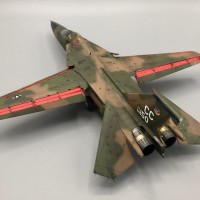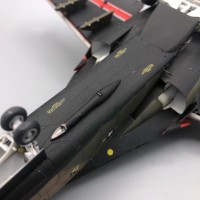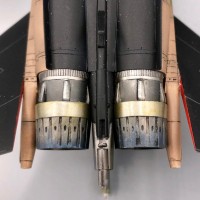A Tail of two Aardvarks
1/72 Hasegawa F-111D, s/n 68-0150, Cannon AFB, NM, 1979
At Squadron-MMD's EagleQuest modeling show last year, I showed a friend, Jerry Hendrickson, a photo of an F-111D I was flying when I lost most of my rudder on a supersonic run many years ago. He told me I ought to make a model of it…as a matter of fact, he kept bugging me about it as did my wife. My excuse that I didn't have the right decals died when Jerry sent me all the decals I needed, so I had no choice but to proceed. The resulting model won a Gold Medal in the Jet Aircraft division at this year's EagleQuest XXVIII.
Here's the story about that flight…
A Winter Flight Over New Mexico
Cannon AFB, NM, 16 JAN 1979
A beautiful winter morning on the high plains of eastern New Mexico. There was not a cloud in the sky for hundreds of miles and temps were in the low 30's. A great day to go fly.
I was an F-111D Instructor Pilot (IP) in the 481st Tactical Fighter Training Squadron based at Cannon AFB. My mission for the day (if I chose to accept it, as they said on Mission Impossible) was to take 1Lt Junior Hill (a new aircraft commander) on his “Dollar Ride” in the F-111D. This was mission TR-2 (transition) in the F-111D training syllabus and entailed showing the new guy the full envelope of the <a href="https://imodeler.com/tag/aardvark/" class="st_tag internal_tag " rel="tag" title="Click for the Aardvark database at iModeler">Aardvark</a>; from fast to slow, high to low. The highlight of the ride was the Mach run where he got to see the plane literally go the “speed of heat”. The friction from the air at those speeds heated the surface of the airplane and the <a href="https://imodeler.com/tag/f-111/" class="st_tag internal_tag " rel="tag" title="Click for the F-111 database at iModeler">F-111</a> had an automatic countdown timer that told us when we had to slow and not exceed the skin heat limits.
We launched about mid-morning with Junior at the controls and headed northwest to the Las Vegas, NM TACAN. This was the start point for the supersonic corridor that ran south to the Salt Flat, TX TACAN, just east of El Paso. Climbing through 30,000 feet, Albuquerque Center cleared us to begin the high-speed run. Junior put both throttles into Zone 5 afterburner and pulled the wings all the way back to 72.5 degree sweep. As the indicated airspeed reached 400 knots, I told Junior to pull back on the stick and hold that airspeed as we climbed and the Mach number increased.
We accelerated smoothly, and there was no real sense of speed as we neared 50,000 feet. The only way we could tell how fast we were going was to look at the Mach meter. The view was awesome. That high above the earth, we could see for hundreds of miles. The horizon was beginning to curve and the sky above was almost black. Though it was near noon, we could see stars above us in the sky. At about 2.3 Mach, I began to feel a slight buzz or hum in the airframe. I thought we might be experiencing Mach buffet and told Junior to back off the “G” loading a bit by pushing slightly forward on the control stick. He did as I asked but things got rapidly worse. We were still accelerating, and soon we were at 2.5 mach. The hum had increased quickly in intensity until it became a heavy, violent vibration that made reading the cockpit instruments nearly impossible. At that time, I had nearly 2000 hours flying various models of the F-111, and had never seen or heard of a situation like what was happening to us. We were in uncharted waters, as they say. Several things went through my mind in more or less random order. Did we still have control of the airplane, because it felt like it was coming apart? If we did have control, could we slow down before it came completely unglued? Lastly, if we didn't have control, we would have to eject at some point, but I didn't want Junior to panic and eject us as 2.5 Mach and 50,000 feet.
I told him that I had control of the aircraft and to “put his hands in his lap and don't touch anything.” I pulled the throttles back to min A/B to slow (idle power at that speed would cause both engines to compressor stall which would make the aardvark a supersonic glider provided the engines didn't blow up first). As I slowed, the intensity of the vibration decreased and once I was subsonic, it was barely noticeable. I declared an emergency and called back to the base to talk to the Supervisor of Flying (SOF). Lt. Col. Larry Colliflower was pulling that duty, and I asked if he had any ideas about what might have happened. I also requested that another airplane join up with us and look us over for any external damage. He said that no one else was airborne to help but that we might have damaged the over wing fairing. This was the hinged top of the airplane that sealed the fuselage to the wing as the wing swept fore and aft. We had damaged a few fairings at Red Flag on occasion, outrunning the Aggressors. We were pretty much on our own, so the best we could do now was fly slowly back to the base and do a “controllability check”. If we could get the airplane into a landing configuration of some sort (wheels down and some slats and flaps) and still have fairly good control, we could land. If not, then Junior could pull the ejection handle and give us the rocket ride of our lives.
As it turned out, the airplane flew well in the landing configuration and the approach and landing were nominal, as NASA would say. I even had a 10-knot direct crosswind from the right, but it posed no problem. As we rolled down the runway with fire trucks all around us, the control tower called and told us that most of our rudder was missing. I could have done a fly-by of the tower before landing to have them look us over but in retrospect I think I would have been more worried about the crosswind landing if I had known the extent of the damage. Ignorance was bliss in this situation.
The post-incident investigation found that the damage to the rudder began right after we took off. The rudder is made up of a high-tech foam aluminum honeycomb to reduce weight. In this case, moisture found its way into the bottom of the rudder between layers of the honeycomb. The heat from the afterburners turned this moisture to steam, which expanded and caused the rudder to delaminate. Once we were supersonic, the shock wave moved aft on the fuselage and became unstable when it reached the delaminated portion of the rudder causing it to vibrate. The yaw flight control computer through the yaw damper tried to counter the vibration. Instead, it caused some sort of harmonic vibration that was out of phase with the actual damper commands. This in turn caused the rudder to flutter at increasingly higher rates and amplitude. Thus, the rudder basically ate itself alive until we slowed subsonic and the shock wave moved forward away from the damaged portion of the rudder. The irony of the whole situation was that the original delamination was about the size of your small fingernail. A piece of aluminum that small almost caused the loss of a 100,000-pound airplane. As the old saying goes, “For the want of a nail, the battle was lost.”
Now for the build:
Finding a kit to build was no problem. Hasegawa makes a VERY nice 1/72 F-111 kits of “all flavors. Their F-111D is superb. The instructions were very easy to follow except for one major point. There was no discussion about whether any weight was needed in the nose to keep the model from becoming a dreaded “tail-sitter”. I asked around on several model forums, but couldn't get a definitive answer. SOOO…I put 1 oz. of lead under the nose hatch and solved that problem once and for all. Eduard color PE helped with the cockpit detail as well a various detail items on the fuselage. Things went together well with really NO filler needed. I did have to build the wings in stages because the flaps and slats required several rounds of painting and masking for the “red areas”. The F-111 is the only USAF aircraft that was operationally painted in this manner. This was a Navy requirement that warned ground personnel of the parts of the aircraft that could be moving during ground/deck handling and posed a potential danger.
The BIG part of the build was “the rudder”. If I couldn't get it right, I was just wasting my time. The real rudder was an aluminum/honeycomb laminate, so I thought I'd give that mode of construction a try. I tried a balsa wood core covered by sheet styrene. It was very hard to get the proper taper to the airfoil, so after several attempts, I gave up on this approach. That left me with one option… “Plastic Surgery”. If I screwed this up, there was no fixing any mistakes. So very carefully, I carved away with my Xacto knife and rotary tools. I worked slowly and constantly compared my work to my photos. All in all, I think it came out OK. I made the static discharger wicks on the rudder and stabs out of .006 inch fly fishing leader. Next, I used ResKit resin wheels. These were nicely molded and the nose tires were actually “chined” like the real deal to keep water on the runway from going into the engine intakes on take-off roll. The final touch was the Master Model metal pitot tube.
I masked the canopy with Eduard pre-cut masks (they are the Bomb) and primed with white Stynlrez to highlight any areas that needed further attention before painting. I painted the jet with Vallejo Model Air paints using the color callouts from the kit instructions. After a sealing coat of Alclad varnish I did the decals. They were a mixture of kit decals combined with those that Jerry and a few other kind folks sent me. I had to do the “CC” tail code and all serial numbers one letter/digit at a time since there were no decals available for this specific aircraft. This took a steady hand and patience while I was camped out under my Opti-Visor. Another gloss coat was applied followed by an oil panel line wash and final coat of Vallejo Satin Acrylic varnish.
So, that's the “tail” of two Aardvarks…I hope you liked it.



















Said you, Tom: "I hope you liked it." Like? I love it! It's a superb build & paint, plus it's all 1st hand, real-life experience.
The camo pattern with red and especially the underneath is outstanding - the black & red is quite good looking. Thanks for the explanation about the red Navy-specified paint. I've wondered WHY - I figured it was some kind of metal finish, much like the chromate green (yellow-green) that has been in use for decades. Now I know the REAL reason for the red ... safety.
Thanks for sharing the build AND the story with us.
One question ... was 1Lt. Junior (Hill) suitably impressed?! LoL! I'll bet he appreciated the fact that YOU took over the flying! And he got to continue on - alive - with his fairly-new career and he was able to learn some VERY valuable lessons!
Jeff, glad I could shed some light on that subject. On an Air Force ramp, you had much more room for the ground crew and everyone pretty much knew when the jet was running. On a carrier flight deck, it was noisier and more crowded...you stayed away from the red.
Can’t say what i Like the most about your post, the superb model or Your first person account flying the Aardvark. All in all a great post, Thanks for sharing with us
Excellent build Tom - in every way, and an incredible story!
Allow me to add my congratulations on your build and a most interesting accompanying narrative. A great post, sir...thanks for sharing it.
A great build! Thanks for sharing your story. You probably could write a book.
The more I look at this model at the places you have posted it, the more I like it. Everything about it is superb.
And, of course, there's the story.
Thanks, high praise indeed from the Master builder and more importantly ...Story Teller.
Wow, that’s a story! And a great model too. Your camouflage airbrushing in 1/72 is superb in addition to the work on the rudder.
This is one of the greatest posts I’ve read on imodeler. I’d assume the experience was a bit nerve-wracking. And, that level of detail in 1:72? Just awesome.
‘Liked’
Matt, your work on your WLA gave me the guts to try my own WLA build a couple of years ago. That project in turn “gave me permission” to expand my skills.
amazing model...your amazing...thank you for your service/ lucky dog...lucky dog
It’s mostly been said, Tom, but this is a post for the ages. A lived experience, a beautiful model, personal connection, and I love a little damage.
Excellent work in every respect.
‘Liked’
What a story and build. Thanks for sharing this with us Tom!
Thanks SO MUCH for sharing your F-111D. Superb build and really interesting personal story.
I have always wanted to build one, not sure I can convince SWIMBO I need one when surveying my vast stash!
Thanks again- fantastic build.
Dan from Bermuda.
Two great stories 1st of all. I will say however that I am not surprised by your coolness in maintaining calm in getting the aircraft in control and manageable before she departed flight. Though we try to anticipate situations that may come about on a flight no matter what the tasking is. What may be routine becomes an adventure and raise the pucker factor exponentially and times like these where the training kicks in automatically. And not just that experience and knowing the characteristics of the aircraft. Still inside we are scared to death but we don't have time to think about that as we go through the checklist in our minds to correct what is going on. Experiencing a situation myself I know the thoughts that crossed our minds momentarily as we take a course of action. And that just shows on the model. Always love the Hase F-111's, still the best kit of the Aardvark in any scale. And wish they would release in 48th scale. Well done sir. Aim high...Chuck USNR
Thanks, Chuck. You described perfectly how the mind works in situations like that. Training kicks in and you save the "fear and reflection" for later. As Goose said, "Let's do some of that Pilot S**t, Mav."
Amazing story and super build! I really really like it!
As beautiful as your model is, the narrative of the day's events is truly captivating and quite un-nerving. Your writing could stand proudly along side of Tom Clancy's. First hand pucker factor conveyed superbly!
Great story and a great plane, once they got it sorted! We used to see these awesome birds over Darwin along with Mirages and then in QLD flying out from RAAF Amberly base. Classic and beautiful plane. Like someone else mentioned, have you ever thought of knocking out a book of your flight experiences?
Thanks, Jimmy. I’ve got a lot of stories, for sure, but sadly I’m not really a writer. I just tell a story here and there. On another note, a very good friend of mine was the USAF F-111 exchange Pilot with the RAAF at Amberley 1980-81. When they came back to the States, they had two cockatoos and his two young sons had Aussie accents, haha.
Though not a fan of the 111, you turned an exciting flying episode into a first-class story in model form. Well done!